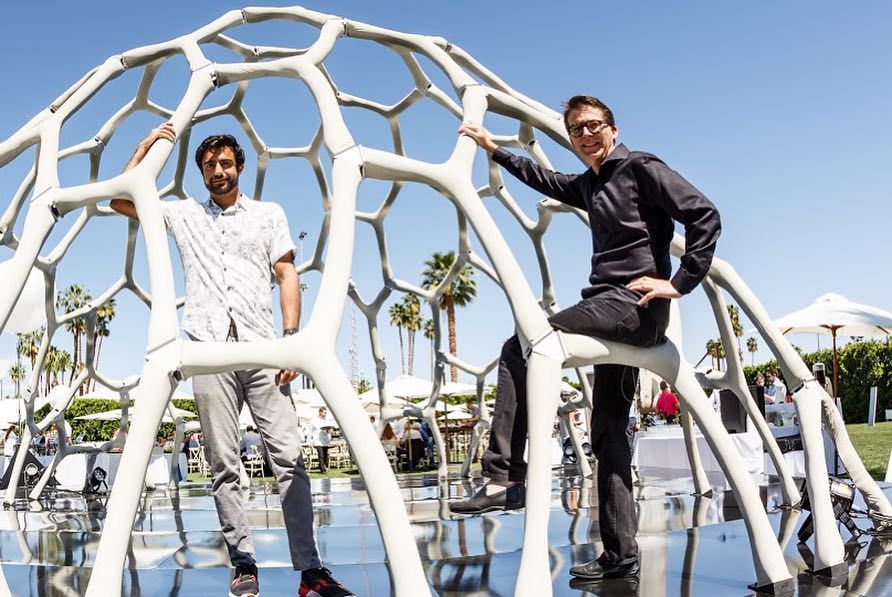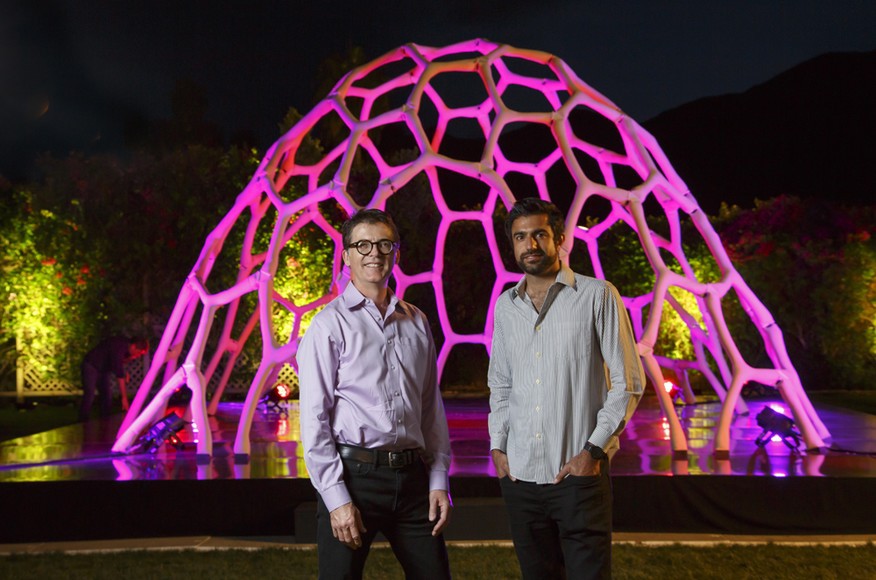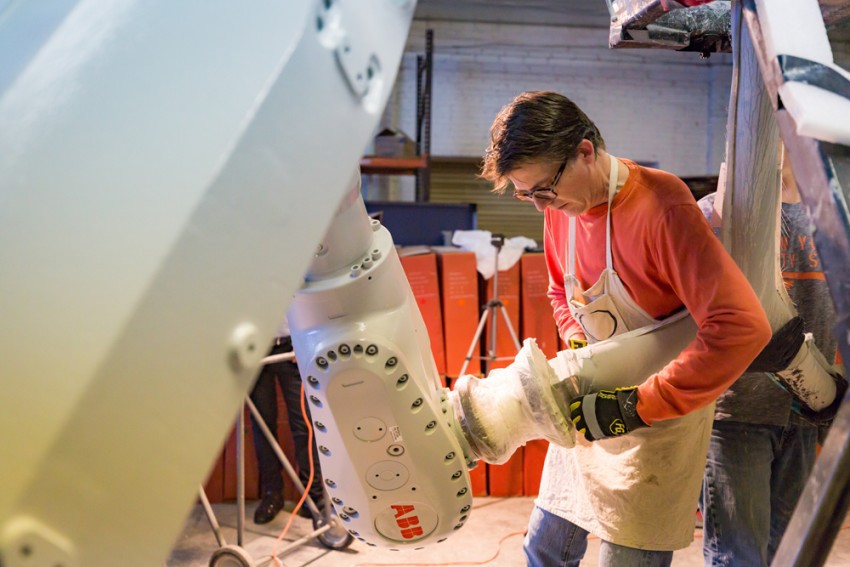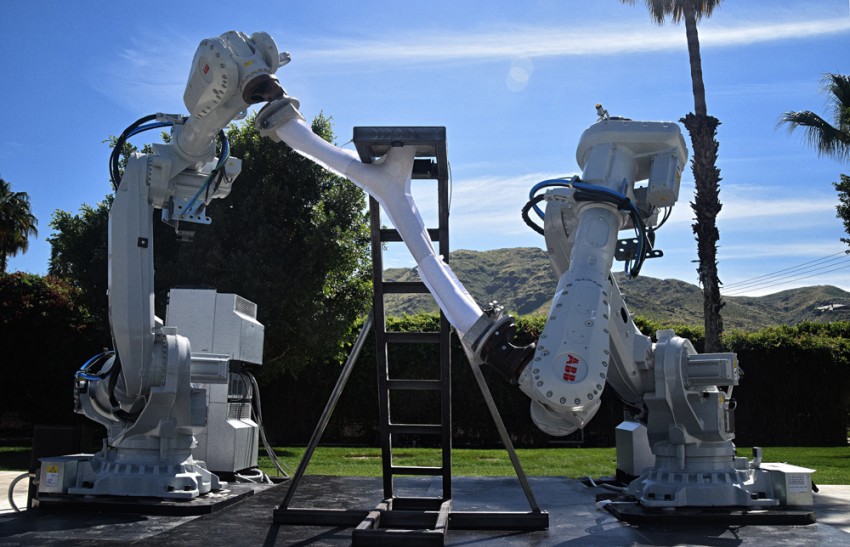
Form Found Design has a very unique way of understanding architecture, a form of connecting nature and technology. This studio, based in Los Angeles, works to conquer the mastery of material and technology, through the exploring advancements in robotics, material science and project workflows. Ron Culver and Joseph Sarafian found a common passion in their career and they realized that they had different skills, but very enriching for each other, that was how they started the project MARS Pavilion.
MARS Pavilion works on the integration of robots in the construction industry. The industrial robot arms manipulate the fabric sleeves, creating an adjustable formwork into which the concrete is poured.

What is the origin of the studio?
Ron and I met while in grad school at UCLA Architecture and Urban Design. We were both in Greg Lynn’s Suprastudio and Julia Koerner’s Technology Seminar. After working together on a few projects, we realized that we each brought different skills, but the same passion to our work. Our early work focused on creating an adjustable mold for concrete. We coupled the precision of robots with the dimensional freedom of fabric to create a flexible formwork for generating a series of wishbone-shaped geometries. We called it Fabric Forms. It was a combination of material research and computational design, which gets at the heart of our company.
We had access to two small Kuka Agilus Robots, and we were able to simulate their movements like characters in an animation. When Ron and I realized the potential application and scalability for our work, we began to publicize it, speaking at the Robots in Architecture conference in Sydney, Australia, and seeing our work published on Dezeen and other websites. When Amazon reached out to us, we knew we needed to form a company.
How did you come up with the idea of breaking up with more traditional architecture and innovating with technology and nature?
We were fascinated with creating organic geometry through a natural form-finding process (fabric + gravity) while simultaneously simulating its behavior through advanced digital simulations, and also choreographing the robots that would stretch the fabric. We were fascinated by the juxtaposition of exploring natural forces through a highly precise and specialized machine. This duality of nature and robot is something that drives every aspect of our design philosophy today. These ideals are still present today when we take on architectural work. We try to seek out the unique relationship between machine and nature.

How is nature introduced in your designs? And technology?
This duality of nature and machine takes on different manifestations in each project. When Amazon commissioned our MARS Pavilion, we used gravity to simulate the geometry of the overall structure using the plugin, Kangaroo 3D which allowed us to create a digital hanging chain model that we inverted to create a networked shell structure whose primary load was compression. In the same way Gaudi used a hanging chain model to derive curvature for his stone arches and vaults, we also derived a geometry that worked within our own material constraints (in our case, steel fiber-reinforced concrete). This allowed our structural engineering firm, Walter P. Moore to use our model (which was already optimized), and run their Finite Element Analysis on each of the concrete members, simulating its performance under various load cases.
Gravity forces also affected the individual “wishbones” as they were positioned and stretched by the 6-axis robot arms. Two robot arms would manipulate two ends of the wishbone, while the third was used as a fill-point for the concrete and Helix Twisted Steel Micro Rebar. The Nylon fabric would sag slightly even while tensioned by the robots, creating slight curvature in each wishbone. This was also simulated in our 3D software to understand the relationship among geometric orientation, gravity, and robotic tensioning forces.
What are the principal advantages that introducing nature and technology gives to your designs?
Our approach to any new problem is heavily rooted in design research. Greg Lynn once talked about a commonality among many of the top world-renowned architects. He said that none of them “start from scratch” when a client approaches them. All have ongoing design research that has been developing over years of interest, whether in a particular geometry, technology, or design strategy. So, when the client approaches them with a commission, they can choose from a catalog of research to continue their explorations.
I saw this first-hand while working for Synthesis Design + Architecture. We would pursue material research, advanced geometry explorations, and other ideas well before a commission came, so that when the opportunity presented itself, we would already have something to bring to the table. This was a big part of Alvin Huang’s philosophy on design research, blending academia and practice, and one that Form Found Design has adopted as well.
You talk about an architecture that is derived rather than contrived, what does that really mean to you?
We believe that architecture is derived from the forces around us. Those forces may be physical, mathematical, cultural, political, etc. So, our job as architects is to harness those forces into a built medium. It is less about the artist with a blank canvas, but more akin to a photographer seeking out a composition in time and space. I’m not downplaying the role of the designer in our process, but augmenting this role with new inputs. There will always be the lens through which we interpret our environment. The role of the individual designer is still as critical as ever. The day we stop absorbing new techniques and ideas is the day we stop being architects. We are constantly seeking new tools to design new things and designing new things that require the creation of new tools.
What has been one of the biggest challenges in the world of architecture?
Our biggest challenges are often the ones we create for ourselves. I believe that engineers solve problems and that architects create problems. This is why the world desperately needs architects and architectural thinking. It’s our own ability to re-frame a problem that is given to us that is both a blessing and a curse. Our office will take on ambitious challenges, but we’ve found a way to surprise even ourselves and rise to the occasion each time to deliver what is needed. Ron and I both have an iterative approach to design, so we will go through many different solutions before arriving at one that satisfies all of our constraints. This can be challenging and require extra time up-front in the design process, but it pays dividends when those explorations start turning into built work.

Which one is the project that meant the most or you have a special connection with?
For us, the MARS Pavilion proved to the world, but also to ourselves that we could do the impossible. Nothing at this scale had ever been built with our system and we proved that we could scale our research to new heights. It was a moment of realization that coincided with a showcase that put our work in front of some of the most influential technologists in the world. I told Ron prior to starting the project that there couldn’t be a bigger stage to succeed on… or to fail on, so we gave it everything we had. That project was a testament to our diverse, yet complimentary skillsets. We like to believe our technical skill both digitally and in construction shows up in each of our projects.
Is there always a message behind all of the designs you develop?
Absolutely, whether it is a desktop object or a multi-story building, we let reason and concept be the impetus behind all of our work. Nothing is random, or arbitrary. If we only solved the problems the owner puts in front of us, we wouldn’t be doing our job. There is always a larger meaning that we imbue into our projects.
What inspires you in order to get to your designs? And which are some of your referents in the world of architecture?
We’re constantly asking questions of our built environment and the natural world around us. We’re inspired by the intricate elegance of design implicit in nature.
Which are the materials that you usually work with? What is the reason for your choice, the look of the materials, the handling, the origin of them…?
We’ve worked with a wide range of materials, both in and out of the office. We are constantly challenging the way materials are used, going beyond their conventional nature into the realm of material performance and creating new effects. We set out to design a high-strength lattice out of concrete for both the MARS Pavilion and the Cytocast Pavilion. Both employed Helix Twisted Steel Micro Rebar in order to achieve the slender geometry and reduce fabrication time. As design problems present themselves, we often turn to advanced material performance to solve new challenges. We are constantly looking for new materials to explore.
What do you think of working with natural stones such as quartz, marble or obsidian?
We’ve used these and are open to new collaborations exploring their potential new applications, including CNC carving and texture possibilities.

